Fruiting trees, bushes, and vines should be pruned in the fall to remove any dead or diseased branches (sanitary pruning). Beyond that, pruning can become quite the controversial subject, with gardeners having very passionate opinions. For example, many will swear by pruning cherry trees in the spring, but this runs the risk of discovering that the plant has already begun to swell and bud and it’s too late for pruning.
Fall pruning, on the other hand, eliminates this concern and allows plenty of time for thinning (removing crossing and otherwise incorrectly growing branches), supportive trimming (shortening back the year’s growth on branches), and formative pruning (done in the first few years to improve structure and shape).




